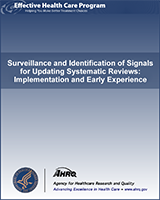From: Introduction

Surveillance and Identification of Signals for Updating Systematic Reviews: Implementation and Early Experience [Internet].
Newberry SJ, Ahmadzai N, Motala A, et al.
Rockville (MD): Agency for Healthcare Research and Quality (US); 2013 Jun.
NCBI Bookshelf. A service of the National Library of Medicine, National Institutes of Health.
